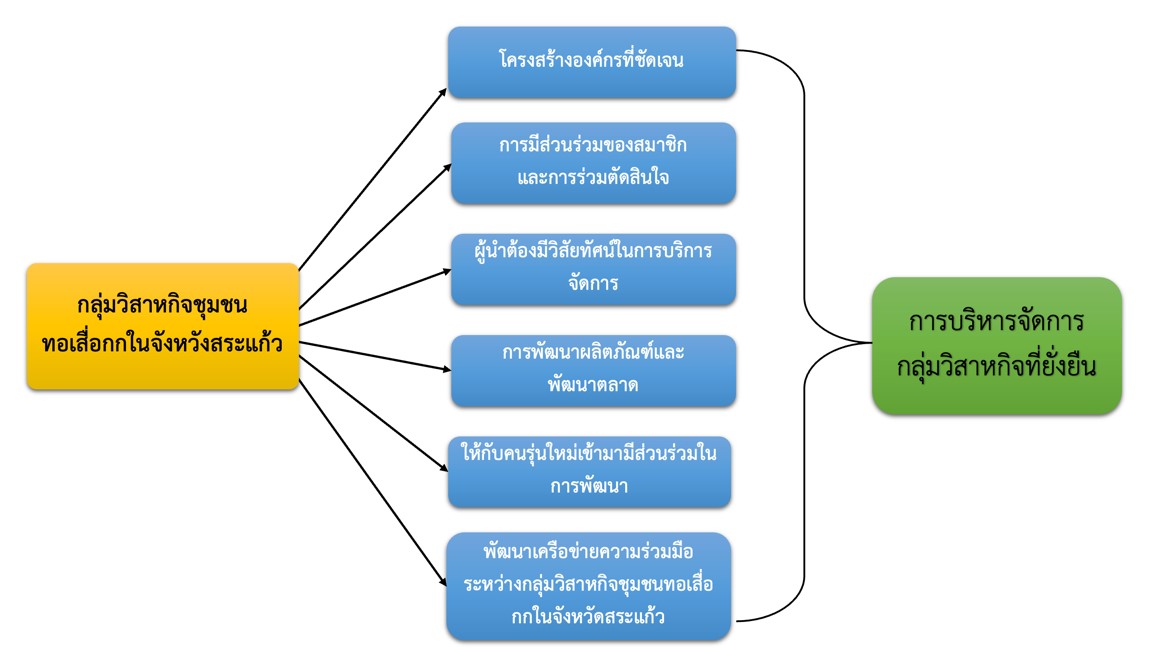Guidelines to Promote the Potentials of Woven Reed Mats Community Enterprise in Sakaeo Province Through Community Participation
Main Article Content
Abstract
The purposes of this research were: 1) the contextual information, potential, social capital and current problems of the mat weaving community enterprises in Sa Kaeo Province; 2) the factors leading to the success of the mat weaving community enterprises in Sa Kaeo Province; 3) the guidelines for strengthening the potential of mat weaving community enterprises in Sa Kaeo Province that emphasize community’s participation. This research uses mixed methodologies. The subjects of this research are the mat weaving enterprises in Sa Kaeo Province, consisting of the Ban Phra Phloeng Mat Weaving and Processing Community Enterprise, Phra Phloeng Subdistrict, Khao Chakan District, Sa Kaeo Province; the Ban Khlong Sip Sam Mat Weaving Community Enterprise, Khao Samsip Subdistrict, Khao Chakan District, Sa Kaeo Province; and the Lai Thong Mat Weaving Community Enterprise, Nong Muang Subdistrict, Khok Sung District, Sa Kaeo Province. Participants consist of 7 people from each enterprise, consisting of their president or representative, totaling 21 people; and 2 district agricultural officers who supervise the subdistrict, totaling 23 people, using the descriptive data analysis model.
The results revealed that:
1. Community enterprises have potential in terms of beautiful mat weaving techniques and sufficiency of raw materials for production. However, there are still problems in operations, such as elderly members, which affects group development and product distribution channels.
2. Factors leading to the success of the mat weaving community enterprises in Sa Kaeo Province include management, leadership, production, marketing, capital, members and communities, knowledge and data management, and external interactions.
3. Guidelines for enhancing the potential of mat weaving community enterprises in Sa Kaeo Province that emphasize community’s participation include networking of community enterprises, family-based operation of community enterprises, and the use of “Community Enterprise Innovation Learning Centers”.
Article Details

This work is licensed under a Creative Commons Attribution-NonCommercial-NoDerivatives 4.0 International License.
เพื่อให้เป็นไปตามกฎหมายลิขสิทธิ์ ผู้นิพนธ์ทุกท่านต้องลงลายมือชื่อในแบบฟอร์มใบมอบลิขสิทธิ์บทความ ให้แก่วารสารฯ พร้อมกับบทความต้นฉบับที่ได้แก้ไขครั้งสุดท้าย นอกจากนี้ ผู้นิพนธ์ทุกท่านต้องยืนยันว่าบทความ ต้นฉบับที่ส่งมาตีพิมพ์นั้น ได้ส่งมาตีพิมพ์เฉพาะในวารสาร วิชาการธรรม ทรรศน์ เพียงแห่งเดียวเท่านั้น หากมีการใช้ ภาพหรือตารางของผู้นิพนธ์อื่นที่ปรากฏในสิ่งตีพิมพ์อื่นมาแล้ว ผู้นิพนธ์ต้องขออนุญาตเจ้าของลิขสิทธิ์ก่อน พร้อมทั้ง แสดงหนังสือที่ได้รับการยินยอมต่อบรรณาธิการ ก่อนที่บทความจะได้รับการตีพิมพ์References
คณิดา ไกรสันติ และรัสมนต์ คาสี. (2559). แนวทางการพัฒนาศักยภาพกลุ่มวิสาหกิจชุมชนสุขาวดี ตำบลปริก อำเภอสะเดา จังหวัดสงขลา. ใน กอแก้ว จันทร์กิ่งทอง (บ.ก.), การวิชาการระดับชาติและนานาชาติ ครั้งที่ 7, 23 มิถุนายน 2559 (หน้า 554-566). สงขลา: มหาวิทยาลัยหาดใหญ่.
จีรเกียรติ อภิบุณโยภาส และปานแก้วตา ลัคนาวานิช. (2562). การพัฒนาศักยภาพการประกอบธุรกิจหมู่บ้านทำมาค้าขาย วิสาหกิจชุมชนกลุ่มข้าวคุณค่า ชาวนาคุณธรรม จังหวัดยโสธร. วารสารวิจัยเพื่อการพัฒนาเชิงพื้นที่, 12(2), 101-118. https://abcjournal.trf.or.th/chabub/n28.aspx
ณรงค์ เพ็ชรประเสริฐ. (2542). แนวคิดและทฤษฎีเกี่ยวกับปัจจัยความสำเร็จ. กรุงเทพฯ: เอดิสันเพลส โปรดักส์.
ปรัชญา เวสารัชช์. (2538). การมีส่วนร่วมของประชาชนในกิจกรรมเพื่อพัฒนาชนบท. (รายงานการวิจัย). กรุงเทพฯ: มหาวิทยาลัยธรรมศาสตร์.
เสริมศักดิ์ วิศาลาภรณ์. (2537). ปัญหาและแนวโน้มการมีส่วนร่วมของประชาชนในการบริหารการศึกษา. เอกสารประกอบคำสอน หน่วยที่ 1-4. กรุงเทพฯ: มหาวิทยาลัยสุโขทัยธรรมาธิราช.
